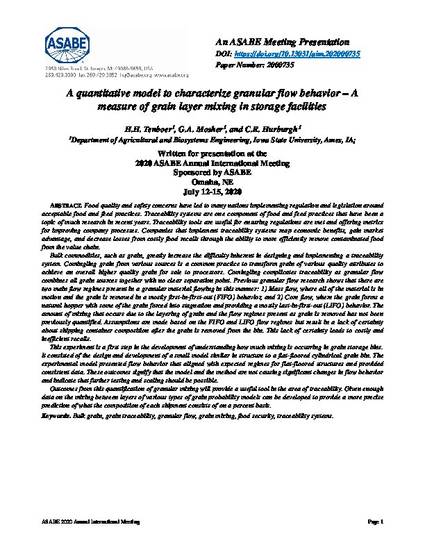
Food quality and safety concerns have led to many nations implementing regulation and legislation around acceptable food and feed practices. Traceability systems are one component of food and feed practices that have been a topic of much research in recent years. Traceability tools are useful for ensuring regulations are met and offering metrics for improving company processes. Companies that implement traceability systems reap economic benefits, gain market advantage, and decrease losses from costly food recalls through the ability to more efficiently remove contaminated food from the value chain. Bulk commodities, such as grain, greatly increase the difficulty inherent in designing and implementing a traceability system. Comingling grain from various sources is a common practice to transform grain of various quality attributes to achieve an overall higher quality grain for sale to processors. Comingling complicates traceability as granular flow combines all grain sources together with no clear separation point. Previous granular flow research shows that there are two main flow regimes present in a granular material flowing in this manner: 1) Mass flow, where all of the material is in motion and the grain is removed in a mostly first-in-first-out (FIFO) behavior, and 2) Core flow, where the grain forms a natural hopper with some of the grain forced into stagnation and providing a mostly last-in-first-out (LIFO) behavior. The amount of mixing that occurs due to the layering of grain and the flow regimes present as grain is removed has not been previously quantified. Assumptions are made based on the FIFO and LIFO flow regimes but result in a lack of certainty about shipping container composition after the grain is removed from the bin. This lack of certainty leads to costly and inefficient recalls. This experiment is a first step in the development of understanding how much mixing is occurring in grain storage bins. It consisted of the design and development of a small model similar in structure to a flat-floored cylindrical grain bin. The experimental model presented flow behavior that aligned with expected regimes for flat-floored structures and provided consistent data. These outcomes signify that the model and the method are not causing significant changes in flow behavior and indicate that further testing and scaling should be possible. Outcomes from this quantification of granular mixing will provide a useful tool in the area of traceability. Given enough data on the mixing between layers of various types of grain probability models can be developed to provide a more precise prediction of what the composition of each shipment consists of on a percent basis.
Available at: http://works.bepress.com/gretchen_mosher/67/

This proceeding is published as Tenboer, Heather H., Gretchen A. Mosher, and Charles R. Hurburgh. "A quantitative model to characterize granular flow behavior–A measure of grain layer mixing in storage facilities." Paper no. 2000735. 2020 ASABE Annual International Virtual Meeting. July 13-15, 2020. DOI: 10.13031/aim.202000735. Posted with permission.